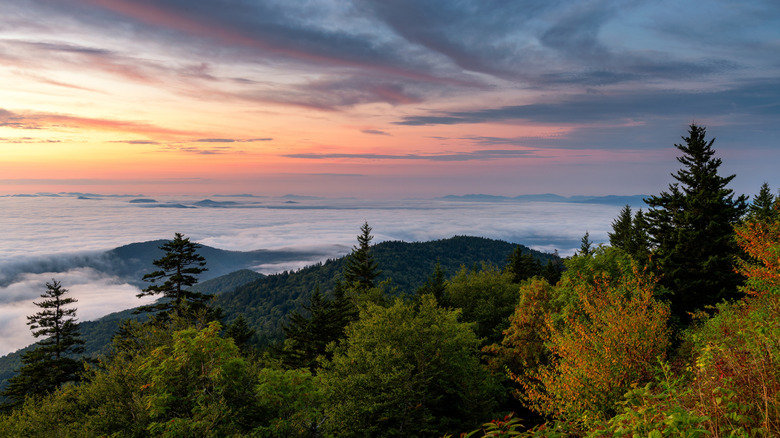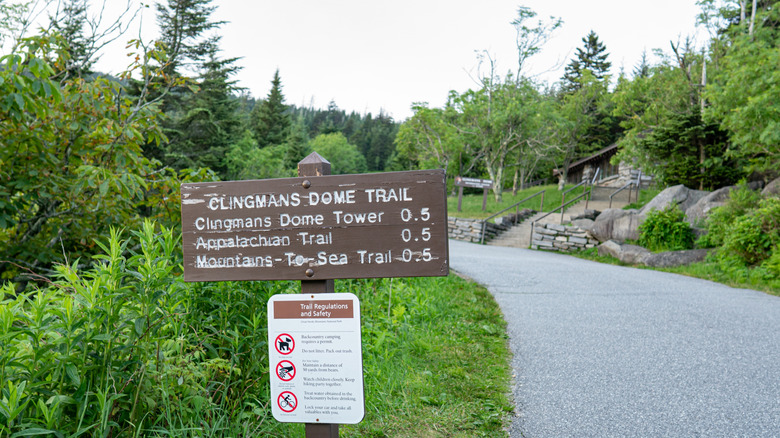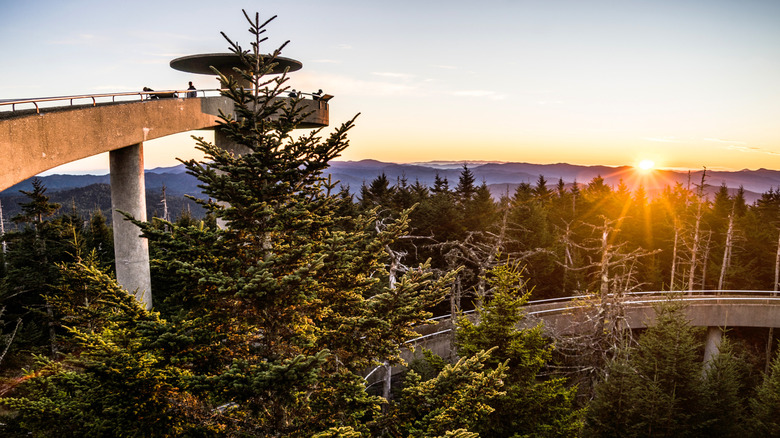Hike Up To The Tallest Point In Great Smoky Mountains National Park For Amazing Views
You could see the Great Smoky Mountains on this bucket list-worthy train ride. Or you could drive through on one of the best national park road trips. But if you really want to feel like you're on top of the world, only a high-altitude hike will do the trick. At the end of this uphill trek, you'll discover Kuwohi (formerly Clingmans Dome), the tallest point in Great Smoky Mountains National Park.
This peak changed names in 2024, swapping out Clingmans Dome, a nod to a Confederate general, for Kuwohi, a Cherokee name meaning mulberry place. While the title changed, this landmark's staggering elevation stays the same. Kuwohi (pronounced koo-WHOA-hee) rises 6,643 feet, making it Great Smoky Mountains National Park's highest peak. Atop Kuwohi, an observation tower leads sightseers further into the air for 360-degree views.
Thankfully, hikers don't need to climb thousands of feet to reach such lofty heights. Kuwohi Trail has an elevation gain of just 337 feet — light work compared to America's steepest dayhikes. Still, visitors should plan and prepare before tackling this trek. Located within one of the country's most visited national parks, Kuwohi sees massive crowds, especially in the summer. For the best experience here, consider visiting in spring or fall. Autumn treats hikers to colorful forest landscapes and (outside of weekends in October) manageable crowds. In spring, crowds thin even further, making conditions ideal for travelers craving solitude. And while a snowy Kuwohi hike may sound like the pinnacle of solitude, unfortunately, the road to the trailhead closes in winter.
Tips for planning your Kuwohi hike
To reach the trailhead, follow US-441 south from Gatlinburg, Tennessee, or north from Cherokee, North Carolina to reach Kuwohi Road. From there, it's 7 miles to the Kuwohi Visitor Center and trailhead. You won't have to pay to enter this or any part of Great Smoky Mountains National Park, but a parking tag is required. Purchase one online or at a visitor center and keep it visible in or on your vehicle while in the park.
Once at Kuwohi Trailhead, drivers must secure a parking space. Despite boasting 167 spots, this area can still fill up fast and be slow to empty. While you can bypass parking woes between March and October thanks to local shuttle services, all hope isn't lost for people bringing their own vehicle. For the smoothest possible parking experience, arrive during off-peak hours (before 8 a.m. or after 2 p.m.). In the summer, parking may also get crowded around sunset. If you're an astronomy enthusiast who can handle traversing dark national park roads, consider visiting Kuwohi at night for some stargazing.
No matter when you visit, know what to expect from the trail. This journey begins at Kuwohi Trailhead, where a stack of boulders flanks the path up the mountain. Ignore the stairway to the left, and follow the paved pathway onto Kuwohi/Clingmans Dome Trail. This moderately challenging out-and-back route covers 337 feet of elevation gain across about a half-mile. At the end of this steep climb, hikers are rewarded with sky-high panoramic views from Kuwohi Observation Tower. Your trek ends by taking the same route back down the mountain for a roundtrip hiking distance of just over a mile.
See for miles from Kuwohi Tower
Once you reach the tallest point in Great Smoky Mountains National Park, give yourself plenty of time to soak in the scenery and explore Kuwohi Observation Tower. Built atop a 6,643-foot-tall peak, the tower may spook some people with a fear of heights, but the sprawling landscapes you can see from the platform make facing those fears worth it. This overlook serves as a prime vantage point for gazing at miles upon miles of forested ridgeline so beautiful that no one would blame you for losing track of time while appreciating the view.
During warm-weather months, those mountain vistas thrum with life as butterflies flit among blooming wildflowers and birds perch on the branches of spruce and fir trees. Between spring and summer, keep an eye out for vibrant scarlet beebalm petals, and listen for the call of birds like the dark-eyed junco. By October, fall foliage overtakes the entire park and paints Kuwohi in hues of red, orange, and yellow. And while winter isn't the most popular time to visit this region due to road closures, seasoned hikers who know how to handle frigid conditions can travel Kuwohi Road or the Appalachian Trail on foot to see the stark beauty that is Kuwohi covered in snow.


